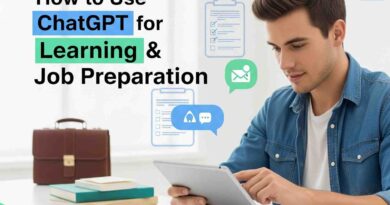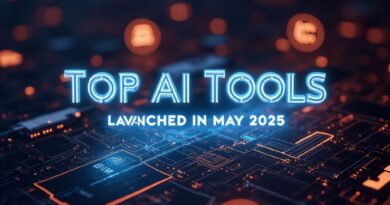What Is AI? Explained in Simple Words for Beginners
What Is AI? Explained in Simple Words for Beginners
Artificial Intelligence (AI) might sound complicated, but at its core it simply means making machines act smart. In other words, AI lets computers or software learn, reason, and make decisions like humans do. You’ve likely seen it in action without realizing it – for example, when your smartphone suggests the next word, or a streaming service recommends movies you like. Broadly speaking, it enables machines to perform tasks that usually need human smarts.

Computers with AI can recognize speech, understand language, identify objects in photos, or even play games against you. As Atlassian explains, it involves creating machines that “can think like humans and imitate their actions,” using techniques such as image recognition, speech understanding, decision-making, and language translation. Think of it as giving machines a type of synthetic brainpower: it’s about programming them to learn from data and experience rather than following rigid rules. For example, an AI program might analyze thousands of pictures of cats and dogs to learn how to tell them apart; once trained, it can spot a cat or dog in new photos on its own.
How Does AI Work in simple words?
Under the hood, most AI systems use machine learning, a process where algorithms study large amounts of data to discover patterns. You can imagine it like how people learn by example. As Atlassian puts it, “learns from examples and data to improve its performance over time”. In practice, engineers feed an AI system huge datasets (like lots of labeled images or text) and an algorithm (such as a neural network) adjusts its internal settings to best match the data. Over time, with more data and practice, the AI gets better – much like you improve at a skill by practicing it.
A powerful type of AI is the neural network, inspired by our brains. These are layers of interconnected “nodes” (like artificial neurons) that work together to recognize complex patterns. For example, a neural network can learn to recognize cats by noticing edges, shapes, and colors in pictures of cats and distinguishing them from other images. Another key concept is Large Language Models (LLMs) – these are AI systems trained on massive amounts of text. They can generate human-like text, translate languages, or even hold a conversation. In fact, OpenAI’s ChatGPT and Google’s Gemini are examples of LLMs. As Atlassian describes, LLMs are “powerful systems that can generate human-like text and help with tasks like writing articles or answering questions. They work by predicting one word at a time, basing each choice on the words that came before – similar to how you might guess the next word in a sentence.
Types of AI (simple words):
In everyday use today, we have Narrow AI – systems specialized for one job (like recognizing faces or translating speech). Hypothetical General AI (AGI) would understand and do any intellectual task a human can; we don’t have that yet. Artificial Intelligence used now, from chatbots to recommendation engines, is narrow but very useful.
Also Read,
New Features in ChatGPT, Gemini & Copilot
Crack HR Rounds as a Fresher: Expert Tips from an Interviewer
Real-World AI Applications
AI isn’t just a theory – it’s all around us, helping in industries from healthcare to entertainment. Here are some examples:
-
Healthcare
AI is making medicine smarter and more precise. For instance in simple words, AI systems can analyze medical images (like X-rays or MRIs) to spot diseases often as well as, or better than, doctors. Google’s AI, for example, was shown to detect breast cancer in mammogram images with 94.5% accuracy, outperforming human radiologists. This means earlier, more reliable diagnosis. Artificial Intelligence also supports personalized treatment: some companies use genetic data and Artificial Intelligence to tailor cancer therapy to each patient. Hospitals use AI to predict patient loads and optimize schedules, improving efficiency. Even routine tasks are powered by AI – chatbots can handle simple medical questions or appointment scheduling, freeing up doctors to focus on complex cases.
-
Education
In the classroom, AI can act like a personal tutor. Learning apps adapt to your pace: for example, the language app Duolingo uses AI to customize lessons for each student, boosting learning retention by about 25%. It also grades assignments and handles repetitive tasks (like enrollment processing), so teachers have more time to teach. A famous case is Georgia State University, which launched an AI chatbot named Pounce. It answers student questions (over 200,000 per year) about financial aid, enrollment, and deadlines, improving student support and reportedly cutting dropout rates by 21%. In short, AI tools can personalize learning for each student and streamline school administration.
-
Entertainment and Media
If you’ve ever wondered how Netflix seems to know what you want to watch, that’s AI too. Netflix’s recommendation engine is AI-driven, analyzing viewing history and ratings to suggest shows you might like. In fact, about 80% of Netflix’s streaming activity is driven by its Artificial Intelligence suggestions. This personalization keeps viewers engaged – Netflix credits AI recommendations with saving over $1 billion per year by reducing customer turnover. AI also creates content: some tools use Artificial Intelligence to generate music, art, or even writing prompts. Games and AR apps use Artificial Intelligence to make experiences more immersive. For example, Pokémon GO adapts its game environment using AI and GPS data, blending the virtual world with real locations. In movies and video, Artificial Intelligence can assist with special effects and editing. In all these ways, Artificial Intelligence delivers entertainment that’s tailored and creative.
-
Business and Industry
Companies across the board use AI to work smarter and faster. Retailers use Artificial Intelligence to manage inventory and predict demand. Banks use AI to detect fraud by spotting unusual transaction patterns. Customer data is analyzed by Artificial Intelligence to personalize marketing – for example, it can recommend products or show tailored ads based on your shopping history. In the workplace, AI tools boost productivity. For instance, Amazon and Walmart use AI-powered robots in warehouses for packing and sorting. General AI-driven analytics help businesses make decisions; McKinsey reports that it could add trillions in value by improving productivity. Even data centers benefit: Google’s DeepMind AI famously optimized server cooling, reducing energy use and saving millions (illustrated above).
-
Customer Service
AI is changing the way companies serve customers. Many websites and apps now use AI chatbots – virtual assistants that can answer questions, process orders, and troubleshoot in real time. Unlike humans, AI chatbots are available 24/7, handling many customers at once. For example, beauty retailer Sephora uses an AI chatbot on its site and app. This chatbot mimics natural conversation to give makeup advice and product recommendations, learning from each interaction to get better over time. The result: faster support and happier customers. Overall, Artificial Intelligence in customer service means quicker answers (no waiting in line!) and personalized help based on past interactions.

Popular AI Tools (ChatGPT, Google Gemini, Microsoft Copilot)
Today’s AI excitement centers on powerful tools anyone can try. Here are a few recent examples in simple words:
-
ChatGPT (OpenAI): ChatGPT is a conversational AI chatbot. It was released by OpenAI in late 2022 and can chat, write essays, code, and more. OpenAI describes ChatGPT as “a model that interacts in a conversational way” (openai.com). It can understand prompts and answer follow-up questions, even admitting mistakes when it’s wrong. ChatGPT’s ability to generate detailed text responses has made it extremely popular for writing help, learning, and fun chats. (You can try it for free at chat.openai.com.)
-
Google Gemini (Google DeepMind): Google’s latest AI is called Gemini. Developed by Google DeepMind, Gemini is designed as a multimodal AI – meaning it can work with text, images, and even audio together. The newest version, Gemini 2.5, is described as a “thinking model” with strong reasoning and coding capabilities. In practice, that means Gemini can answer complex questions, explain tricky subjects, and even help write or debug code. For example, Google notes that Gemini can “understand text, images, audio and more at the same time,” making it good at explaining complicated topics. Google is integrating Gemini into tools like Google Search and Docs to help users ask questions and get smarter answers.
-
Microsoft Copilot: Microsoft has built AI assistants into its Office suite. Copilot for Microsoft 365 integrates GPT-like models with your own files and data. As Microsoft explains, Copilot “combines the power of large language models (LLMs) with your data in the Microsoft Graph and the Microsoft 365 apps”. In other simple words, Copilot can help write Word documents, analyze Excel spreadsheets, craft email replies in Outlook, or even generate a PowerPoint from your notes – all by understanding natural language commands. You might type “Draft a status update on our project” and Copilot will gather info from your emails and meetings to create a draft. This AI assistant is designed to make routine work tasks faster and more creative.
Other popular AI tools include image generators like DALL·E 2 (by OpenAI) or Midjourney, which can create artwork from text descriptions; virtual assistants like Apple’s Siri or Amazon’s Alexa; and niche bots for tasks like scheduling or translation. But ChatGPT, Gemini, and Copilot highlight how it is entering writing, coding, and office work today.
Conclusion
Artificial Intelligence is not magic – in other words it’s a set of technologies that enable machines to learn and think in human-like ways. It works by feeding data into algorithms so they “learn from experience”. Today’s Artificial Intelligence systems power many conveniences and innovations in daily life. From diagnosing diseases to tutoring students, from making your music playlist to assisting in your work emails, AI tools are everywhere.
For beginners, the best way to see it in action is to try some tools and notice them in everyday services. Tools like ChatGPT and Google Gemini show how advanced the technology has become. Trusted companies and labs (like OpenAI, Google DeepMind, Microsoft, and IBM) offer more reading on it.
As it continues to improve, learning the basics will help you understand news about it and make informed choices about using it. But at the end of the day, it is simply a useful tool – one that can make our lives more efficient and creative. By demystifying What is Artificial Intelligence, we hope beginners feel ready to explore and benefit from the AI-powered world around them.
📤 Stay Updated with NextGen Careers Hub
📱 Follow us on Instagram
📺 Subscribe us on YouTube
Please share our website with others: NextGenCareersHub.in






Pingback: Top 7 High-Paying Freelance Tech Skills to Learn in 2025 (No Experience Needed) - Telugu Careers Hub